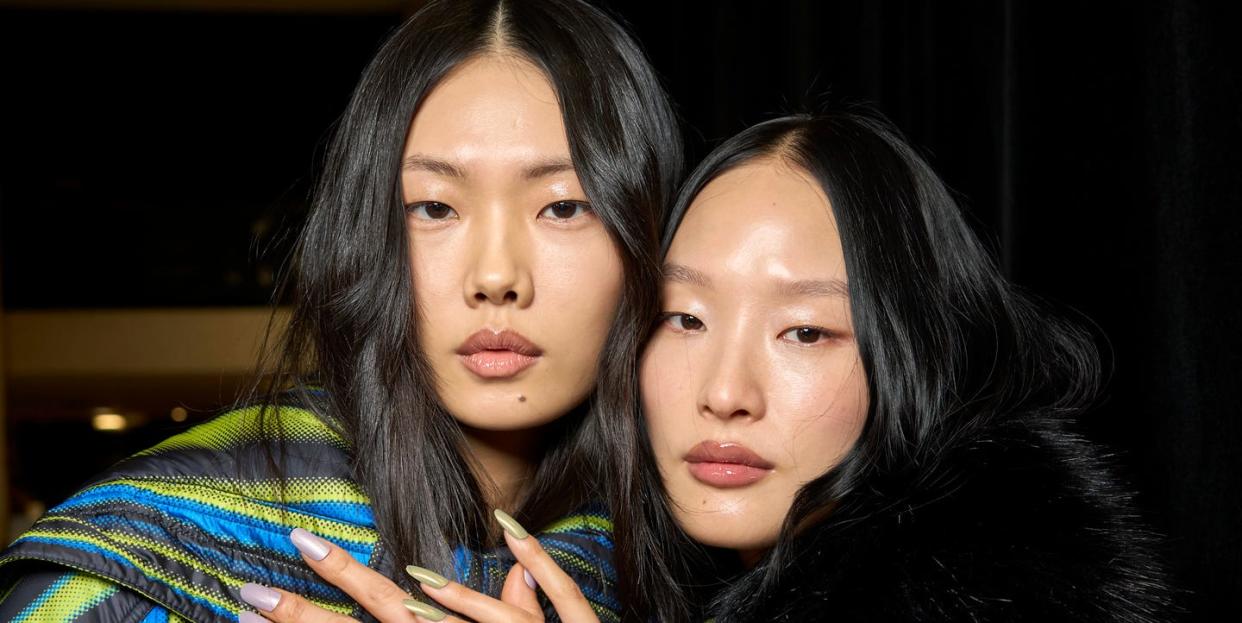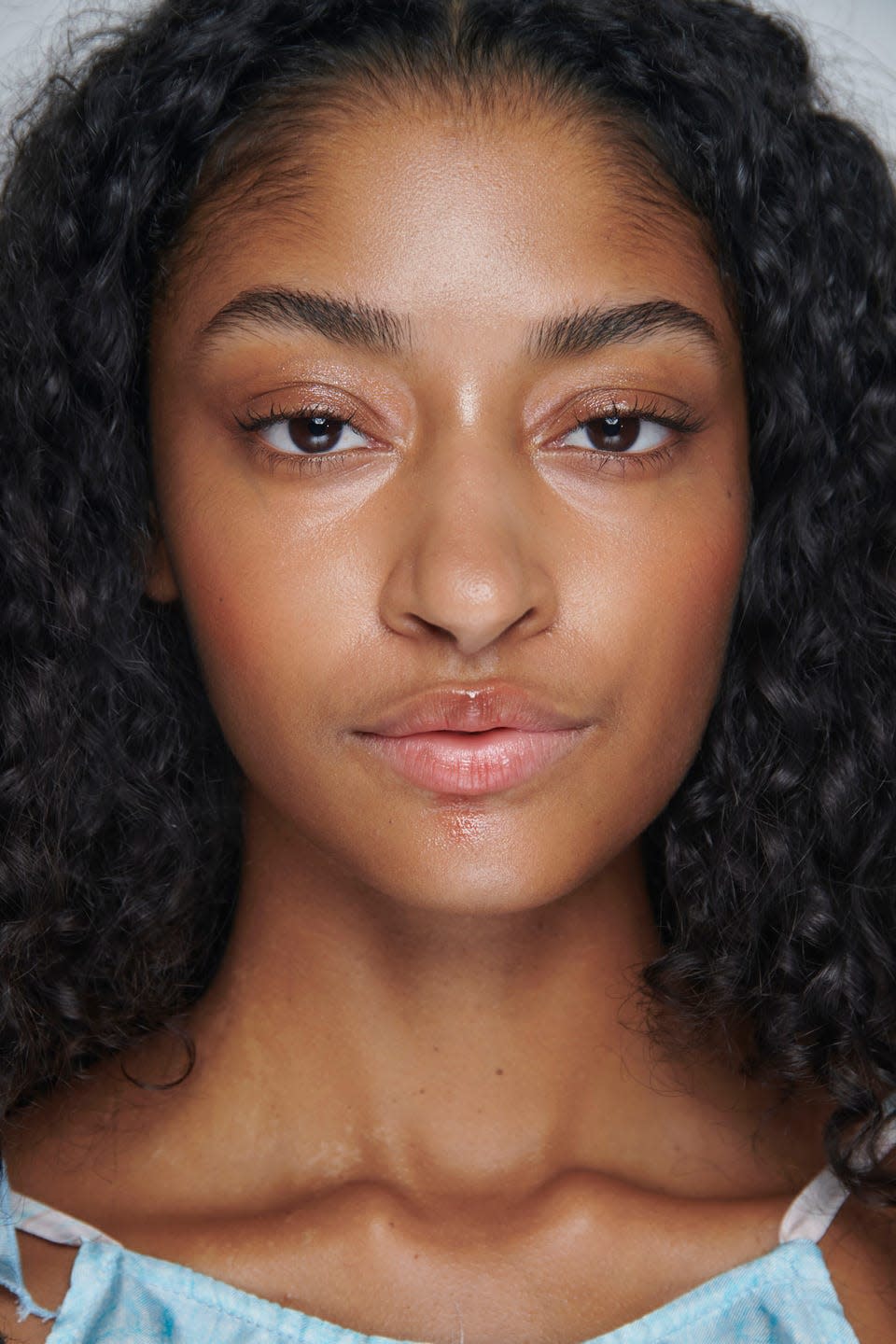Can Hypochlorous Acid Really Prevent Acne?

Search ‘hypochlorous acid’ on TikTok right now, and you’ll find countless it-girls – each with spotless, radiant skin, no less – generously misting their faces. Some are sat on airplanes, spritzing between layers of gloopy hydrating serums and occlusive creams; others are breathless in the gym changing rooms, freshening themselves with the cooling sensation. Either way, they’re raving about it.
Hypochlorous acid, once an unsung dermatologic hero, is now the latest darling of the social media world, hailed as the ultimate acne-preventing powerhouse. Now, it’s something the ELLE beauty team are applying morning, night and multiple times in-between.
FIND OUT MORE ON ELLE COLLECTIVE
But as with any viral sensation, we approached it with a healthy dose of scepticism – after all, a spray that claims to prevent blemishes does sound too good to be true. To get the real story, we turned to dermatologists to find out if this so-called wonder ingredient lives up to the hype. Below, you can discover how it actually works, and the best way to incorporate it into your skincare routine.

What is hypochlorous acid?
‘Hypochlorous acid is a weak acid that has antibacterial properties. In other words, it’s a disinfectant,’ says Dr Alexis Granite, consultant dermatologist and founder of Joonbyrd.
Hypochlorous acid isn’t just used for skin, however; you’ll also find it on the ingredients list of some household products, like surface cleaners. You’d be forgiven for finding this alarming, but ‘the form used in skincare is very diluted (100 parts per million) to ensure dermatologic safety. It’s created using a mixture of salt, water and vinegar via a process called electrolysis,’ adds Dr Granite. So, not to worry.
How does hypochlorous acid work?
Put simply, the sensitive-skin-friendly ingredient helps to reduce bacteria within our pores that contribute to acne. ‘It mimics the body’s natural defence mechanisms. It helps to neutralise harmful bacteria, reduce inflammation and promote the healing of damaged tissues. It’s ability to oxidise and break down pathogens without causing irritation is what makes it so effective and suitable for all skin-types,’ explains Kimberley Medd, head of clinic at Face The Future.
‘However,’ Benjamin Moffatt, managing director of Isoclean caveats, ‘it’s important to remember that bacteria isn’t the only thing that causes acne, so you should also include other breakout-busting ingredients in your skincare routine, such as salicylic acid and benzoyl peroxide too.’
What are the benefits of hypochlorous acid?
Effectively cleanses the skin and kills acne-causing bacteria.
Calms inflammation, reduces redness and relieves itchiness – including the symptoms of eczema, rosacea and psoriasis, as well as sunburn and razor rash.
Repairs cuts and wounds by speeding up the skin’s healing process.
Are there any risks with using hypochlorous acid?
Nope! Unlike most acne treatments, hypochlorous acid is tolerated well by all skin types and it's rare to endure an adjustment period or any irritation. ‘Hypochlorous acid is actually produced naturally by immune white blood cells within our skin to protect against microorganisms,’ adds Dr Granite.
‘However, as with any skincare product, it’s advisable to patch-test a small area of skin first, especially if you have any known sensitives or allergies,’ Medd advises.
How to use hypochlorous acid
It’s an extremely easy, flexible product to incorporate into your routine; there's no one 'right' way to use it. Typically, it’s applied morning and night to clean skin, prior to other leave-on products, like serums and moisturisers. Just make sure the product has dried on the skin before you do, though: ‘due to its unique chemical properties, the acid may interact with and inactivate a number of ingredients, especially antioxidants such as vitamin C.'
You can also mist hypochlorous acid over the face and wipe away the excess with a cotton pad for a gentler cleanse in the morning.
Or, if you’re in a pinch after the gym and unable to cleanse your face immediately, you can use a spritz of hypochlorous acid to disinfect the skin. ‘It shouldn’t replace your usual post-workout skincare routine though,’ says Moffatt. ‘So, by all means, use hypochlorous acid at the gym to cleanse and refresh your skin, but only until you’re able to properly wash the sweat, dirt and other breakout-causing build-up from your pores.’

Can you take hypochlorous acid on airplanes?
Absolutely, and it’s a smart move too. If you can find a bottle under 100ml (luckily, most come in a handy-dandy travel size) bring hypochlorous acid in your carry-on luggage and mist every few hours to combat the notoriously germ-laden cabin air. Just be mindful not to inadvertently mist your seatmates.
For us, this is where in-flight skincare routines start and finish. While it’s true that the dry, recirculated air can be unkind to your skin, there’s no need to layer on excessive moisture. In fact, 'layering too many products - especially if your skin isn't used to this many products at once - can lead to clogged pores and irritation,' explains Dr Hanson, aesthetics doctor at Dr Hanson Clinic. 'The reality is, airplanes aren't a sanitary environment, no matter how carefully you wash your hands.'
Our best advice? Keep your hands away from your face during the flight to avoid transferring germs from potentially unclean surfaces. Thankfully, applying hypochlorous acid is a breeze—no hands required.
Can you use hypochlorous acid with retinol?
‘Yes, hypochlorous acid can be used in conjunction with retinol. Since it is non-irritating and soothing, it can help to counteract some of the potential side effects of retinol, such as redness and irritation. Apply hypochlorous acid first to clean skin, let it absorb [and dry fully], then follow with your normal retinol product,’ explains Medd.
So, can hypochlorous acid really prevent acne?
'For the most part, my skin behaves well,' begins beauty assistant Chloe Woodland, 'but I battle with a few blemishes every month, as most people my age [23] do. I've been using a hypochlorous acid spray for a few weeks now, mostly post-cleanse to settle my rosy cheeks and red, inflamed hormonal spots, and I'm getting on well with it.
I've noticed a twice-daily spritz helping to keep breakouts at bay, and preventing clusters of spots forming, as they tend to do on my face. I still get monthly breakouts, but they're more under control now.
My favourite way to use the ingredient is straight after the gym, while I'm still in the car. I normally can't wait to get home and cleanse my skin, before any sweat or dirt can worm its way into my pores, but this ritual soothes the itch in the meantime. Sometimes I use it to replace my morning cleanse if I feel I can go without it.
It's a pretty fail-safe addition to any skincare routine, and handy to have around for added defence against pesky spots and blemishes. It'll do some of the heavy-lifting, but you'll need to use it in conjunction with other acne treatments to see a real difference. For once, this is a TikTok trend I'm happy to co-sign.'
ELLE Collective is a new community of fashion, beauty and culture lovers. For access to exclusive content, events, inspiring advice from our Editors and industry experts, as well the opportunity to meet designers, thought-leaders and stylists, become a member today HERE.
You Might Also Like


